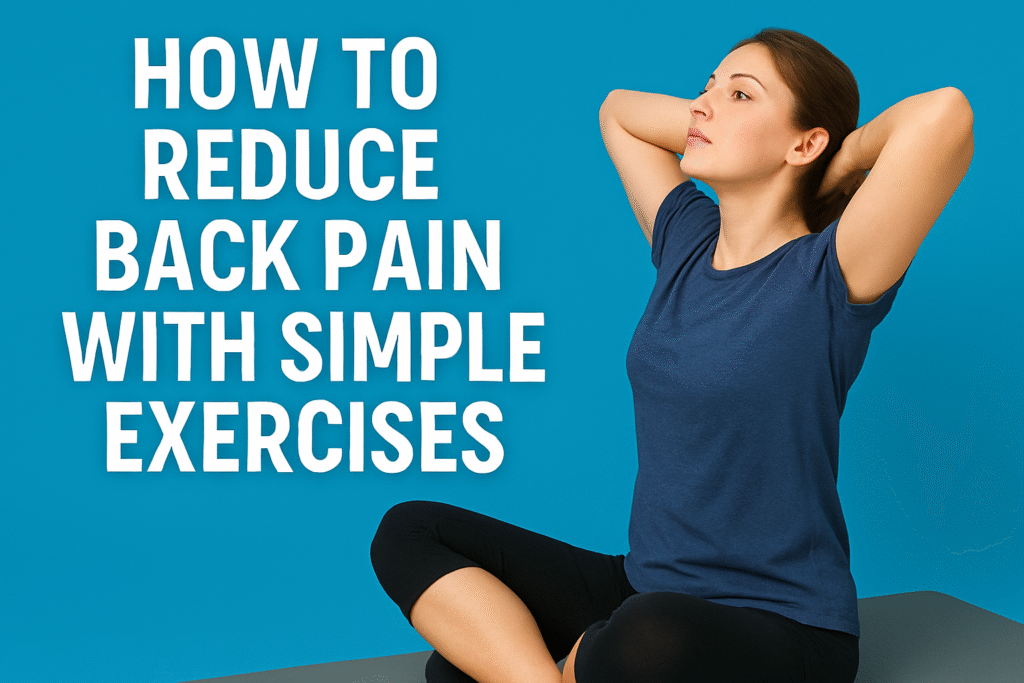How to Reduce Back Pain with Simple Exercises

Let’s be real—back pain sucks.
Whether it creeps up after a long day at your desk or hits you out of nowhere when you’re just trying to tie your shoes, it can seriously mess with your mood and your plans. The good news? You don’t need to become a yoga master or join a fancy gym to start feeling better.
In fact, a few simple exercises can go a long way toward reducing (and even preventing) back pain—especially if you’re just getting started.
Let break it down, step-by-step.
Why Does My Back Hurt?
Before we jump into the exercises, it helps to understand why back pain is so common. Spoiler alert: It’s not always about “getting older.”
Here are some usual suspects:
Poor posture (hello, slouching at the computer)
Weak core muscles (your abs and back are a team)
Tight hips or hamstrings
Lack of movement or too much sitting
A lot of the time, your back is picking up the slack for other parts of your body that aren’t doing their job. So instead of only targeting your back, we’re going to focus on strengthening and stretching your whole core system.
The Golden Rule: Keep It Simple
If you’re new to exercising—or if your back’s already cranky—the last thing you want is to overdo it. that exercises are gentle beginner-friendly and don’t require any special equipment. A yoga mat or soft surface helps, but that’s about it.
Here are 6 simple exercises you can start doing today.
1. Cat-Cow Stretch
This one feels amazing—especially if you’ve been sitting all day.
How to do it:
Start on your hands and knees, wrists under shoulders, knees under hips.
Inhale, arch your back, lift your chest and tailbone (this is “cow”).
Exhale, round your back, tuck your chin and pelvis (this is “cat”).
Move slowly between the two for 1–2 minutes.
Why it helps:
This stretch improves spinal mobility and gently warms up your back muscles.
2. Child’s Pose
Think of this one as a built-in back massage.
How to do it:
Kneel on the floor, sit your hips back toward your heels.
Stretch your arms forward and rest your forehead on the floor.
Breathe deeply and relax for 30 seconds to a minute.
Why it helps:
Child’s pose gently stretches your lower back and relieves tension. It also helps calm your nervous system—win-win.
3. Glute Bridge
Time to wake up those glutes—because weak glutes = more strain on your back.
How to do it:
Lie on your back with knees bent, feet flat on the floor.
Press your feet into the ground and lift your hips toward the ceiling.
Squeeze your butt at the top, hold for a second, then lower down.
Do 10–15 reps.
Why it helps:
Strong glutes help support your spine and take pressure off your lower back.
4. Knee-to-Chest Stretch
Simple, gentle, and very effective.
How to do it:
Lie on your back, bend your knees, and bring one knee toward your chest.
Hold it with both hands for 20–30 seconds.
Switch sides. Do 2–3 rounds each leg.
Why it helps:
This stretch loosens up your lower back and hips, especially after sitting.
5. Bird-Dog
Don’t worry—no dogs required. Just you and your core.
How to do it:
Get on your hands and knees.
Extend your right arm and left leg straight out.
Hold for a few seconds, keeping your back flat.
Return to start and switch sides.
Do 6–10 reps each side.
Why it helps:
This move builds stability in your core and lower back without straining your spine.
6. Pelvic Tilt
Tiny movement, big difference.
How to do it:
Lie on your back with knees bent, feet flat.
Flatten your lower back into the floor by gently tilting your pelvis.
Hold for a few seconds, then release.
Repeat 10–15 times.
Why it helps:
Pelvic tilts strengthen the deep muscles that support your spine and help you improve posture.
A Few Tips Before You Start
Move slowly: These aren’t fast-and-furious workouts. Quality > quantity.
Listen to your body: If something feels painful (not just tight), back off.
Consistency is key: A few minutes a day beats one giant session once a week.
And remember—these exercises are meant to help your back, not push it past its limits.
How Often Should I Do These?
You can safely do most of these exercises every day, especially the stretches. If you’re feeling sore or stiff, even 10 minutes can make a difference. Over time, you’ll build strength, improve mobility, and (hopefully) notice a lot less back pain.
When to See a Pro
If your back pain is severe, comes with numbness or tingling, or just isn’t getting better no matter what you try—it’s time to check in with a doctor or physical therapist. Sometimes your body needs more than what at-home exercises can offer.
Back pain might be common, but it doesn’t have to be your normal.
With just a few simple exercises each day, you can take pressure off your spine, strengthen your core, and start feeling better—without needing to join a gym or spend hours stretching.
Start small. Stay consistent. Your back will thank you.






